

Sam Himelstein, PhD
Sam Himelstein is the founder and CEO of the Center for Adolescent Studies, Inc. He is passionate about working with youth and training the professionals that serve them.
2 Simple Tips to Create a Welcoming, Trauma-Informed Classroom Space
Whether you’re leading a mindfulness class, an academic class, or a therapy group, it’s important to create a healing-centered, growth-oriented space where youth feel respected and comfortable.
On the first day of class, I like to discuss openly the types of behavior that will help everyone to feel safe in the group and that will help everybody stay on task. Note that this is quite different from me creating a list of rules that the students must follow. To keep this post short, check out “4 Simple Tips for Creating Group Agreements” to help you plan how to create agreements that result in emotional safety in your class.
There are also a couple of ways you can make your physical classroom space more welcoming and trauma-informed.
1) Posters and Images
What kinds of images and photos are on the walls? Do they contribute to the type of atmosphere you’re trying to promote? Do they reflect the content of your lessons? Do the students relate to the images? Do they feel safe and comfortable in this space?
It’s very effective to post your group agreements. It could be a class project to create a colorful, artistic poster, which will help everyone remember the agreements and feel part of the process of creating them.
When I teach my substance abuse curriculum, I put all of the major principles on the wall. For example, when I teach Lion Mind vs. Dog Mind, a concept for teaching mindfulness, I have them put a picture of a lion and a dog on the wall to constantly remind them to use their lion minds. (See Cultivating the Lion Mind: A Mindfulness Metaphor That Sticks).
You can also include quotations from people the youth look up to, who look like them (same gender and ethnicity) and who’ve done inspirational things. Reflecting on quotes from their heroes can really impact young people’s lives, especially when they see them over and over again.
Think about your context and what would be most effective. If you’re teaching an academic class, you may have posters on the wall related to the content you’re teaching. Do any of these posters represent the culture and ethnicity of your students? For example, if you have portraits of historical figures, are at least some of them from the same countries of origin as your students? If you have photos of scientists, are at least some of them the same race and gender as your students?
When I worked in the maximum security unit at juvenile hall (detention center), some of the youth would be there so long that they would graduate from high school while they were incarcerated. Every time one of my clients graduated, I would get a copy of their diploma, and I would post them on the wall. After I’d worked there for a few years, I had more than fifty diplomas on my office wall. That meant that one of the first things youth saw when they walked into my office was a wall full of diplomas. This was highly motivating for them, as it got them thinking that they might be able to graduate, too.
2) Hand-Held Balls and Gadgets
One of the most important ways to help traumatized youth is by giving them opportunities for movement. Continuous, rhythmic movement can help traumatized youth to self-regulate by stimulating their central nervous system.
If you have the budget (which I admit is unlikely for most), it would be great to invest in some under-desk bike pedals, or treadmills or workout bikes with a shelf to put a book or computer. Rhythmic movement supports emotional regulation, so slowly walking or cycling while doing their work can help youth to stay calm and on-task.
Since that may not be realistic, a much more cost-effective option is to give the the kids something to do continuously and rhythmically with their hands.
A few options are:
- soft stress balls (palm-sized squeezable balls),
- ‘twisties’ (twistable rubberized sticks),
- traditional Chinese stress balls (a set of metallic balls that fit into one palm), and
- fidget spinners (a type of small flat toy, like an easy-to-spin top).
In a perfect world, kids would never frustrate you and disrupt the class by throw the balls at each other or bouncing them off the walls. There is, of course, a big difference between the intended purpose of a stress ball and what youth actually do with them. However, the potential for misuse isn’t a reason to give up a technique that could be very beneficial under certain circumstances, for example if one of your students is triggered by something that comes up in class and needs to get back into the window of tolerance. For more on the Window of Tolerance, see “A Critical Intervention for Working with Traumatized Youth.”
You can be trauma-informed and still have boundaries and consequences for getting carried away with playing with the gadgets. In the long run, these types of small manipulable objects can help with group management and behavioral management, especially if their appropriate use is included in the Group Agreements.
The point is that when the youth get stressed out, there’s something available in the classroom that they can use to help mitigate that stress and anxiety, or the precipitating factors that can trigger their trauma.
Conclusion
In ending this brief post, I want to acknowledge that probably the most impactful trauma-informed practice on a systemic school level is that youth are not over-crowded in classrooms, have adequate access to resources, and teachers are treated fairly. Right now as I’m about to publish this post Oakland Unified School District (Oakland, CA) and Denver Unified School District (Denver, CO) are about to go on strike. They are following in the footsteps of the successful Los Angeles Unified School District (Los Angeles, CA) strike in the fight against poor working conditions (salary being the least of the demands).
The 2 major practices presented in this article are by no means a substitute for greater systemic issues, but can be helpful in contributing to a more welcoming environment for your students. Some of what was mentioned (e.g., under-desk cycles) requires a budget that you may not have, while other practices are fairly easy to incorporate (racial, ethnic, gender, sexuality represented in posters on the walls).
Seemingly small decisions can make a huge difference in creating a classroom space that’s not only trauma-informed but is also culturally respectful and reinforces the content that you’re teaching. To the extent that you have control over your space, it’s worth putting some time and effort into setting up the room in a way that will be most welcoming and beneficial to your students.
Join the FREE Resilience Community for Helping Professionals to learn more about trauma-informed care, resilience, mindfulness, building relationships, and more! Our community features self-paced courses, a monthly live Zoom call, a weekly live meditation, and an online platform to connect with other providers/professionals in your field.
Related Posts
A Critical Intervention for Working with Traumatized Youth
10 Essential Guidelines for Teaching Meditation to Trauma-Impacted Youth

